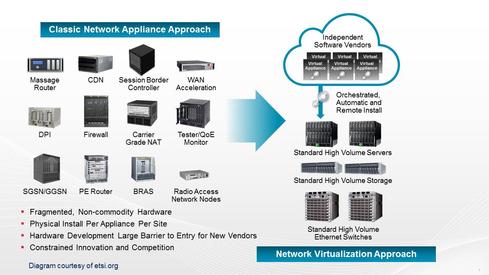5 NFV Benefits & The Trends Driving Them5 NFV Benefits & The Trends Driving Them
Network functions virtualization addresses several trends shaping service provider networks.
May 30, 2014

These days, millions of consumers and businesses are connected to a network in one form or another. As a result, the systems and datacenters used to transport and house content are getting bigger, more pervasive, and increasingly complex. Add to this the explosive amount of data crossing the network, and it quickly becomes apparent that companies and service providers face a daunting challenge.
Network functions virtualization (NFV) promises to ease the burden by granting service providers the flexibility to move network functions from dedicated appliances to generic servers. Using standard IT virtualization technology, NFV aims to consolidate many network equipment types on to industry-standard, high-volume servers, switches, and storage; doing so makes the networks more agile and efficient.
NFV also is flexible, cost-effective, scalable, and secure. With these benefits, NFV addresses several trends shaping service provider networks.
Flexibility: Operators looking to quickly deploy new services require a much more flexible and adaptable network -- one that can be easily and quickly installed and provisioned.
Cost: Cost is a top consideration for any operator or service provider these days, even more so now that they see Google and others deploying massive datacenters using off-the-shelf merchant silicon (commoditized hardware) as a way to drive down cost. Cost is also reflected in opex -- how easy it is to deploy and maintain services in the network.
Scalability: To adapt quickly to users' changing needs and provide new services, operators must be able to scale their network architecture across multiple servers, rather than being limited by what a single box can do.
Security: Security has been, and continues to be, a major challenge in networking. Operators want to be able to provision and manage the network while allowing their customers to run their own virtual space and firewall securely within the network.
Virtualization in another service provider network: To meet customers' needs better, service providers want the ability to substantiate their service anywhere in the world using virtualization.
Let's take a closer look at how NFV addresses these trends. By its very nature, NFV makes network and service provisioning more flexible. That allows operators and service providers to scale services up or down quickly to address changing demands. Those services are delivered via software applications on any industry-standard server hardware, one of the most important of which is expected to be security gateways. Rather than buying a hard asset, service providers can simply take the function associated with the asset and instantiate it as a virtual machine on a server.
Because the network functions are implemented in software, they can be easily moved to various locations in the network without having to install new equipment. That means operators and service providers won't need to deploy as many hard assets. Instead, inexpensive, high-volume server infrastructure can be deployed with virtual machines running on top. That's where the cost savings comes in, but NFV's use of virtual machines (software) also makes it scalable.
On top of that, the virtualization eliminates the dependency between a network function and its hardware, allowing operators to have a local or regional presence without needing the infrastructure to support that presence.
Figure 1: 
Additional cost savings and benefits are possible depending on how NFV is implemented, using either a server CPU or an approach that marries a server-class CPU with best-in-class networking. The initial implementation of software only cannot address most networking workloads, and its use of IT standard hardware limits the applicability of NFV to just a few applications. The latter approach, a hybrid model of processing and acceleration hardware, not only delivers the power efficiency and improved performance operators and service providers demand, but it does so at a much lower cost.
It's clear that NFV can address the key trends confronting operators and service providers. However, as with any new technology, the road ahead is lined with pitfalls. Despite that, proof of concepts are under way. If all goes well, NFV will soon be transforming the way operators design and implement networks and network services for the better.
About the Author
You May Also Like




